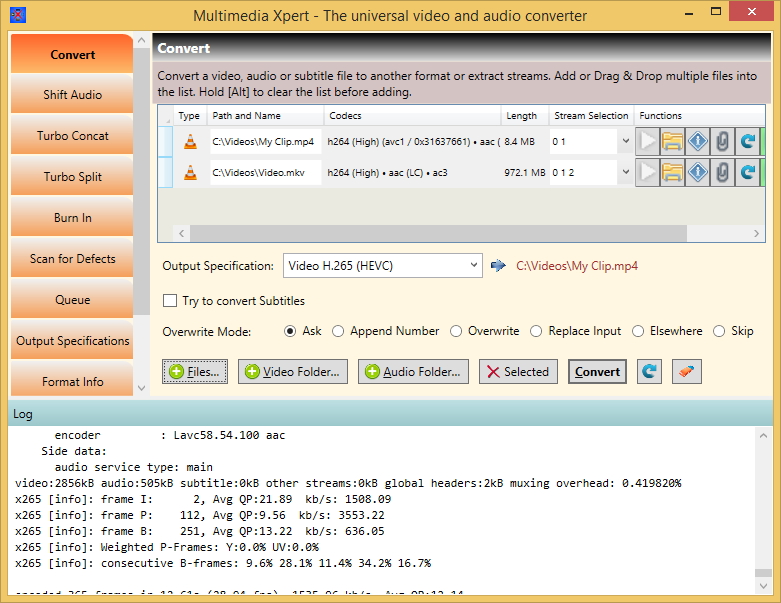|
|
Multimedia Xpert can convert between a massive number of video formats. It can be viewed as the universal video converter. If your player can't play a format, no problem, Multimedia Xpert will fix it. At this time it supports
and the numbers are constantly growing. What is most important: The algorithms work reliably! Here are some frequently used conversions:
Multimedia Xpert is near to converting anything to anything correctly. It can be extremely frustrating if you just get a black screen or an error message after one long hour of processing. Also, not everybody would like to install one program for each single format whereas there is one program than can do it all, and with high reliability. Mass conversionMultimedia Xpert is specifically designed to convert many files in a single pass without user input. As a specialty, it can also convert files directly in place. More info about that in overwrite management. Making file sizes smallerA conversion can be used for making file sizes smaller to bring down upload/download times. To achieve this you can reduce the bit rate, frame rate or image size of the video. Repairing partially damaged filesSometimes media files get damaged during the transfer or transport by USB stick or other medium. If the damages are not too big there is a good chance that a file can be repaired. Just convert it to the same format. The conversion algorithms are quite tolerant and will recover whatever possible. You will end up with a file that has some parts skipped but at least it's a fully valid one which can be played by every media player without any problems. Multimedia Xpert simplifies such conversions by a built-in Inplace Replacement method that doesn't require entering a new name. Extracting audioThis processing page can be used to extract audio tracks of a video into an audio file. This can be useful especially for music videos. It's also used by many people to convert lectures in front of an audience from video to audio. In many cases there is very little to see and they are therefore very good suited as podcasts during sports activities or travel. By making use of the extraction range in the output specification it's also possible to extract just a part, eg. a nice song in the credits of a movie. For this to do you switch to the Output Specification page and choose resp. create a specification of type 'Audio'. Selecting and/or adding streamsIn the past streams were called "tracks", but today the word stream is more common. During the conversion, you have the option to pick some streams/tracks from the input and at the same time add new ones ( Extracting Subtitle StreamsIf your input file contains subtitles streams you can extract all of them with a single click. Each subtitle stream will be put in a single file beside the input file. To be able to do this you wil first have to select an output specification of type 'Subtitle' and enter your desired subtitle format there. Then you will get a new button 'Extract Subtitles' in the conversion window. Viewing the converted mediaAfter a conversion the green buttons in the grid will perform some functions on the converted output. We recommend
Solutions for conversion problems
|
|



